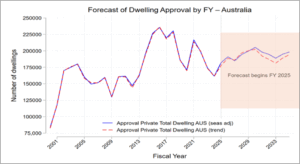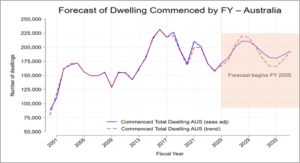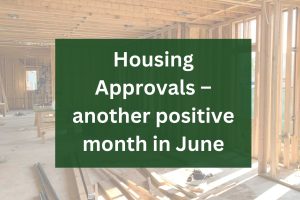As part of FWPA’s ongoing program to enhance the functionality and value of its Data Dashboard, the Australian Dwelling Forecast Dataset has now been incorporated into the platform as a downloadable file. This dataset is updated monthly, following the release of the latest dwelling approval figures by the Australian Bureau of Statistics (ABS), to ensure users have access to timely and relevant information.
The forecasting methodology is based on a Vector Autoregressive (VAR) model, which captures the dynamic relationships between key housing indicators, including dwelling approvals, commencements, completions, and alterations. The model also integrates a range of macroeconomic and demographic variables, including total softwood sales, the mortgage index, the Consumer Price Index (CPI), and population trends. Put simply, the forecast model looks at how changes in key housing and broader economic indicators affect each other to project future changes in housing supply.
This approach offers a comprehensive and data-driven perspective on the housing market, enabling more informed industry planning and decision-making.
Forecast Private Dwelling Approval based on the ABS release in June 2025
- The forecast estimated that total dwelling approvals (houses and multi-units) will increase by 13%, rising from approximately 162,000 in FY2023-24 to 182,000 in FY2024-25. These additional 20,000 approvals are attributed mainly to government incentives aimed at boosting housing supply.
- Multi-unit approvals are expected to grow significantly by 24% over the next two years, as they can be delivered more quickly than detached houses. Timeframes for houses remain steady at around 9 to 12 months.
- Between 2025 and 2035, a total of 2.13 million dwelling approvals are projected, comprising 1.17 million houses (55%) and 966,000 multi-units (45%).
Figure 1: Private dwelling approval forecast 2025-2035

Sources: ABS, FWPA Data Dashboard of Australian Dwelling Forecast Dataset June 2025.
Forecast Private Dwelling Commencement based on the ABS release in June 2025
- Following the increase in dwelling approvals, the number of dwelling commencements is forecast to rise by 10% in FY2024–25, from approximately 157,000 to 172,000. This upward trend is expected to continue through to 2028, with an average annual growth rate of 8%.
- Between 2025 and 2029, it is projected that nearly 975,000 dwellings will begin construction, comprising 515,000 detached houses and 460,000 multi-unit dwellings. Despite this growth, the figures still fall short of the Government’s target of 1.2 million new dwellings within that period.
- Multi-unit commencements are forecast to grow strongly by around 30% over the next two years, reaching close to 100,000 units by 2026, up from the current level of 60,000 under construction.
- Similar to approvals, between 2025 and 2035, a total of 2.1 million dwellings are projected to commence, comprising 1.16 million houses (55%) and 951,000 multi-unit dwellings (45%).
Figure 2: Private dwelling commencement forecast 2025-2035

Sources: ABS, FWPA Data Dashboard of Australian Dwelling 0Forecast Dataset June 2025.
As outlined in the forecast methodology paper (available in the FWPA Data Dashboard), the estimations are based on a set of related variables included within the model framework. These variables are primarily domestic and reflect historical relationships between dwelling activity and key economic indicators. However, the model does not account for potential external factors, such as changes in the global economic environment, international supply chain disruptions, or shifts in migration trends, nor does it incorporate the effects of future government interventions or policy changes. As such, the forecasts should be interpreted within the context of these limitations.
Follow the link below to subscribe and access the FWPA Data Dashboard: https://fwpa.com.au/industry-info/fwpa-data-dashboard/



